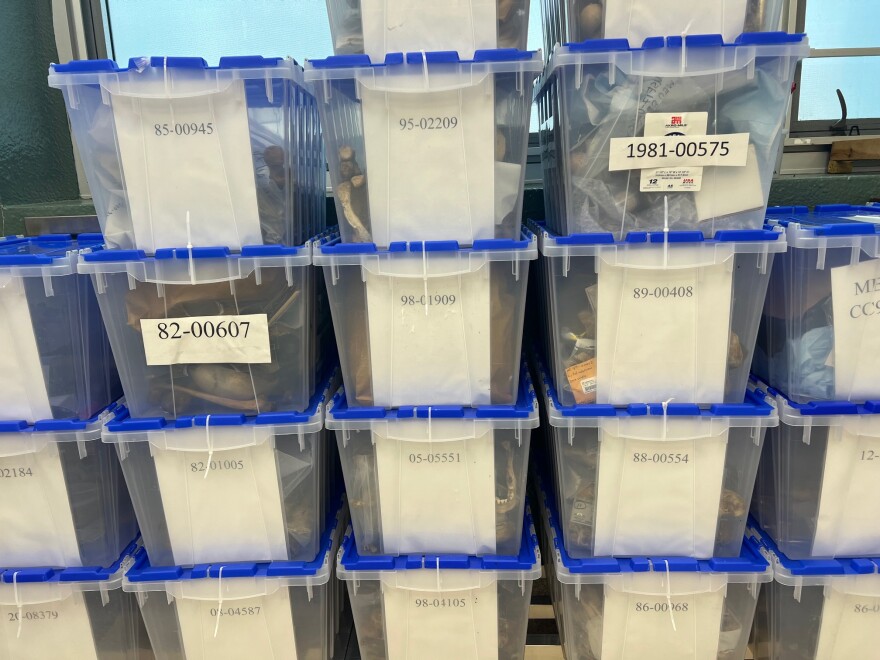Millions of Americans are sharing their DNA with online companies to learn more about their family history, and some investigators are harnessing that information to solve cold cases.
The Hillsborough County Medical Examiner’s Office hopes this emerging technology can help with the county’s 50 unidentified human remains cases, some dating back to the 1970s.
These remains, including bones and items like clothes and accessories, lie in bins in the examiner’s office awaiting breakthroughs that could determine the person who died.
In the past, when attempts to identify these individuals with methods like fingerprinting, facial reconstruction or common DNA analysis didn’t work, there was little else professionals could do, according to Blake Patel, cold case investigations supervisor with the county.
Now, he said, they have another option.

Using DNA to find a match
Known as forensic genetic genealogy, the practice involves submitting an unidentified person’s DNA profile to sites where members of the public can also share their information, in the hopes of matching with a potential relative. Investigators then build family trees around that match to find the person they’re looking for.
“Identifying these individuals, first and foremost, shows respect to these people who've passed away without a name or anyone knowing who they possibly were. And also provides answers to families who may be missing their loved ones,” said Patel.
Traditional DNA analysis has relied on a national combined database run by the FBI known as CODIS, which has some limitations. Most of the DNA samples are from people involved in the criminal justice system or close relatives of missing persons. The genetic profiles entered into CODIS also use parts of DNA that can typically only produce matches with immediate family members.
Websites like Ancestry and 23andMe, on the other hand, produce genealogy profiles with more extensive information that can identify potential matches with distant relatives.
These two larger companies don’t allow law enforcement or medical examiners to search their databases. But users can choose to download their DNA reports from those sites and upload them to other platforms like GEDmatch and FamilyTreeDNA, where information is more publicly available. The more people who do that, Patel said, the easier it could be to identify missing persons.

“We can use someone who may be first-cousin twice-removed, second-cousin, and so on and so forth to be able to build these family trees and narrow down who this person may be,” said Patel.
Questions about privacy arise
That's what recently helped the county identify Charles Allen Ray. He was found dead in 1985. After decades of no answers, family tree research led investigators to a potential brother, who took a DNA test and confirmed the match.
Forensic genetic genealogy has raised privacy concerns since the method made headlines in 2018 for helping law enforcement authorities catch the Golden State Killer, who committed numerous murders, rapes and other crimes in California in the 1970s and 1980s. Some critics have called for more regulations.
Staff at the Hillsborough Medical Examiner’s Office say they abide by the rules that are in place, including limiting searches to users who have agreed to make their information accessible for investigations and trying to exhaust other forensic identification methods before turning to genetic genealogy.
More state and local agencies in Florida are using this technique to solve cold cases. This month, the Florida Legislature passed a bill to establish a statewide grant program through the Florida Department of Law Enforcement to help pay for these efforts, which can cost thousands of dollars per case. If Gov. Ron DeSantis signs it, the law will go into effect July 1.
How to help solve Hillsborough’s cold cases
The Medical Examiner has a list of the county’s 50 unidentified human remains on its website. It includes information and facial reconstructions about each individual.
Officials encourage anyone who may know something about these unidentified people to call (813) 914-4537.
If you’re interested in sharing your genetic data on a site like GEDmatchor FamilyTreeDNA to potentially aid in violent crimes or unidentified remains investigations, experts advise you read the privacy agreements and discuss with loved ones to make a more informed decision.
Copyright 2024 WUSF 89.7. To see more, visit WUSF 89.7. 9(MDAyNDY5MjM1MDEyODE2MzMyMTZmZDQwMg001))






